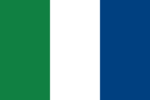User:ReCharged/Sandbox/Luthesia

|
United Kingdom of Luthesian States Vereinigtes Königreich Luthesischer Staaten (Gaerman) Capital: Reun
Population: 9,959,200 (2021) Motto: « Together we fall, together we rise » |
Loading map... |
Luthesia (Gaerman: Luthesien, pronounced [luthˈeziːn̩]), officially the United Kingdom of Luthesian States is a sovereign country located in the southeast of Uletha, also known as Eastern Uletha.
It has about 10 million inhabitants, with an average of 192 inhabitants per km² (496 per sq mi). However, most of the settlements are concetrated around the Bay of Reun, also known as the Reun Lowlands metropolitan region.
Luthesia borders three countries (UL28a, Samaņe and Remsfalen, with the first being the biggest neighbour) and the Darcodian Sea in the north.
The total area of Luthesia is 52,170.64 km² (20,143.20 sq mi), therefore it is one of the smaller countries in Uletha.
Luthesia's capital is Reun, the cultural, economic and financial center with a population of around 2.6 million people. Luthesia consists of eight states: Nabur, Brehmland, Barowingen, Westerland, Nessen, Soren, Osterland and the city state of Reun.
History
Prehistory
The first forms of settlements from modern humans existed in the area of today's Brehmland about 15,000 years ago. It is unclear from which part of the world the people came to this area and why, but it is clear that they found fertile soil in the Reuner Becken (Reun Lowlands) area on the banks of the Brehm. It is believed that people moved south from northern Uletha about 20,000 years ago and settled here, among other things. This is corroborated by findings of human bones from the same period, whice coincide with those from nothern Uletha.
First settlements
In the course of time, the indigenous people colonized other areas of today's Jahta, as well as parts of UL28b and developed into different tribes over time. The best known are probably the Jalten (Yalts) and the Boromunder (Boromunds), who were among the biggest tribes. There were also the tribe of the Nessanier (Nassanians), who were mainly to be found in the south and the Soyerner (Soyrans), who lived in the east on both banks of the Trenz. There were also a large number of smaller, less long-lived tribes.
It is believed that the first small settlements formed around the turn of the millenium. These include, for example, Reun (50 AD), Tremur (70 AD) and Mayn (80 AD), as well as Beyburg (20 BC) and Leonfurt (50 BC), which is considered the oldest city in Jahta. Further settlements followed shortly afterward with Lechermund (100 AD), Maistadt (250 AD) and Plonn (300 AD).
Boromundian Empire (approx. 400 AD - 1020)
Over time, the Boromund area developed into a flourishing empire under Albert II. It stretched from today's Westerland, across the Brehmtal to the Trenztal. In the beginning, simple palisades were built for defense in the border area, but later watchtowers and even massive fortifications were added in the border area and were later also called Tames or Tameswall (from the old Yaltic word temoris = border).
The Boromunds did, however, trade with the surrounding tribes, which helped the economy to boom. The first trade routes to Reun, Leonfurt or Resel were also established here. At this time, the term for today's name for Jahta’s inhabitants seems to have emerged. The Boromunds traded the most with the Yalts, which over time became a general term for people living outside the border wall.
Around 950 AD the Boromundian Empire was exposed to constant battles with the Yahtian tribes. Finally the empire collapsed in 1020 after the Mayner Schlacht (Battle of Mayn) and with it increased prosperity in the empire.
Dark Ages (1020 - 1170)
After the collapse of the Boromund Empire, prosperity had become a distant word. The Yahtian tribes devastated the empire and the Boromunds disappeared. Ongoing battles for land and resources among each other shaped the next decades and wars were mostly short and brutal.
Geography
 | |
|---|---|
| Geography of Luthesia | |
| Continent | Uletha (Eastern) |
| Population | |
| Area | |
| • Total | 52,170.64 km2 20,143.20 sq mi |
| • Water (%) | 19% |
| Population density | 192 km2 496 sq mi |
| Major rivers | Brehm, Trenz |
| Time zone | WUT+7 |
Government
| Government of Luthesia | |
|---|---|
| Parlamentary democratic monarchy | |
| Capital | Reun |
| Head of state | |
| • Monarch | Philipp III |
| • Minister of state | Christian Maatschke |
| Legislature | Luthesian Parliament |
| • Upper house | National Council |
| • Lower house | State Council |
Major political parties | |
Marked in bold, the current government. NLP: 70 NEO: 15 Freibeuter: 8 Grünen: 30 DVP: 32 LVP: 18 KNP: 4 FPL: 19 Other: 4 | |
Economy
 | |
|---|---|
| Economy of Luthesia | |
| Free market economy | |
| Currency | Luthesian Leons (Ƚ) (LEN) |
| Monetary authority | Luthesische Nationalbank |
| GDP (PPP) | 2020 estimate |
| • Total | $ 629.772 billion |
| • Per capita | $ 63,235 |
| HDI (2020) | 0.906 very high |
